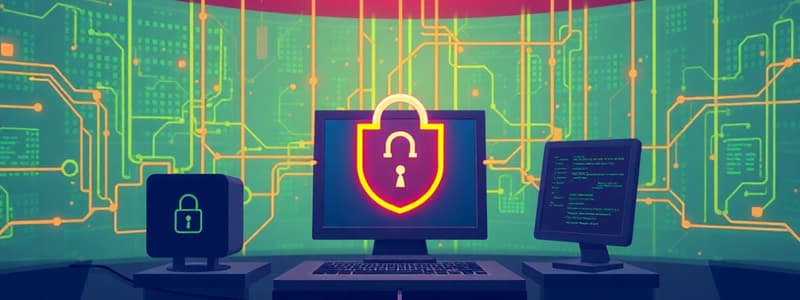Podcast
Questions and Answers
What is a DDoS attack primarily aimed at achieving?
What is a DDoS attack primarily aimed at achieving?
- Accessing confidential data
- Spreading malware through downloads
- Overwhelming a destination to limit its resource responsiveness (correct)
- Stealing user credentials
What refers to a network of compromised computers controlled by a threat actor in a DDoS attack?
What refers to a network of compromised computers controlled by a threat actor in a DDoS attack?
- Zombie Network
- Phishing Network
- Botnet (correct)
- Rogue Network
Which security strategy emphasizes securing all devices on a network?
Which security strategy emphasizes securing all devices on a network?
- User education and awareness
- Restricted access policies
- Single-layer security
- Defense in depth (correct)
Which of the following is NOT typically considered a layer in network attack mitigation?
Which of the following is NOT typically considered a layer in network attack mitigation?
What does the acronym AAA stand for in network security?
What does the acronym AAA stand for in network security?
How can network attack mitigation provide quick responses to security threats?
How can network attack mitigation provide quick responses to security threats?
What method can be used to restore systems after a security breach?
What method can be used to restore systems after a security breach?
Which of the following best describes a man-in-the-middle attack?
Which of the following best describes a man-in-the-middle attack?
What could be considered a maintenance threat?
What could be considered a maintenance threat?
Which of the following is NOT classified as a hardware threat?
Which of the following is NOT classified as a hardware threat?
What is a significant risk associated with viruses?
What is a significant risk associated with viruses?
Which type of malware presents a deceptive front but contains a backdoor?
Which type of malware presents a deceptive front but contains a backdoor?
What are the consequences of electrical threats such as non-stable power?
What are the consequences of electrical threats such as non-stable power?
Which of the following is an example of an environmental threat?
Which of the following is an example of an environmental threat?
What is a primary purpose of network security fundamentals in the course?
What is a primary purpose of network security fundamentals in the course?
What is the primary characteristic of a worm compared to a virus?
What is the primary characteristic of a worm compared to a virus?
Which of the following is considered a common security threat on a network?
Which of the following is considered a common security threat on a network?
What is often overlooked in a physical security plan?
What is often overlooked in a physical security plan?
What type of vulnerability encompasses misconfigured Internet services?
What type of vulnerability encompasses misconfigured Internet services?
What is a major consequence of not having appropriate security policies in place?
What is a major consequence of not having appropriate security policies in place?
Which of the following describes a threat actor in the context of network security?
Which of the following describes a threat actor in the context of network security?
Which of these vulnerabilities relates to technology rather than configuration?
Which of these vulnerabilities relates to technology rather than configuration?
What role does physical security play in network security?
What role does physical security play in network security?
What is a significant risk associated with using default settings in network equipment?
What is a significant risk associated with using default settings in network equipment?
What is the main goal of a ransomware attack?
What is the main goal of a ransomware attack?
Which method is commonly used to gain access to a system in an access attack?
Which method is commonly used to gain access to a system in an access attack?
What distinguishes a denial of service attack from access attacks?
What distinguishes a denial of service attack from access attacks?
What is a common technique employed in password attacks?
What is a common technique employed in password attacks?
How does a man-in-the-middle attack operate?
How does a man-in-the-middle attack operate?
What is a trust exploit in the context of access attacks?
What is a trust exploit in the context of access attacks?
What is typically involved in a reconnaissance attack?
What is typically involved in a reconnaissance attack?
Which of the following best describes port redirection?
Which of the following best describes port redirection?
What is the primary function of firewalls in network security?
What is the primary function of firewalls in network security?
Which of the following is NOT one of the common types of firewalls mentioned?
Which of the following is NOT one of the common types of firewalls mentioned?
What does the 'Authorization' component of AAA do?
What does the 'Authorization' component of AAA do?
Which mitigation technique is focused on inspecting all incoming packets to ensure they are legitimate responses?
Which mitigation technique is focused on inspecting all incoming packets to ensure they are legitimate responses?
What aspect of system maintenance is often overlooked as a means of mitigating attacks?
What aspect of system maintenance is often overlooked as a means of mitigating attacks?
What is the role of a demilitarized zone (DMZ) in network architecture?
What is the role of a demilitarized zone (DMZ) in network architecture?
Which method allows for filtering website access based on keywords or URLs?
Which method allows for filtering website access based on keywords or URLs?
What does accounting in the context of AAA involve?
What does accounting in the context of AAA involve?
What is a critical aspect of device security mentioned in the content?
What is a critical aspect of device security mentioned in the content?
What is the preferred length for passwords according to the guidelines discussed?
What is the preferred length for passwords according to the guidelines discussed?
Which of the following best represents a method of password complexity mentioned?
Which of the following best represents a method of password complexity mentioned?
What does 'hardening' a system involve?
What does 'hardening' a system involve?
What is considered a poor password practice according to the content?
What is considered a poor password practice according to the content?
What is the function of Cisco's auto secure setting features?
What is the function of Cisco's auto secure setting features?
Which of the following is a suggested method for creating a memorable password?
Which of the following is a suggested method for creating a memorable password?
What should be done immediately upon accessing a new system?
What should be done immediately upon accessing a new system?
Flashcards
Threat Actors
Threat Actors
Actions or individuals that exploit vulnerabilities in a network to cause harm.
Technology Vulnerabilities
Technology Vulnerabilities
Weaknesses in network protocols, operating systems, or equipment that can be exploited by threat actors.
Configuration Vulnerabilities
Configuration Vulnerabilities
Weaknesses arising from poor configuration of network devices, services, or user accounts.
Administrative Vulnerabilities
Administrative Vulnerabilities
Signup and view all the flashcards
Physical Security
Physical Security
Signup and view all the flashcards
Disruption of Service
Disruption of Service
Signup and view all the flashcards
Data Loss or Manipulation
Data Loss or Manipulation
Signup and view all the flashcards
Credential Theft
Credential Theft
Signup and view all the flashcards
Electrical Threats
Electrical Threats
Signup and view all the flashcards
Maintenance Threats
Maintenance Threats
Signup and view all the flashcards
Malware
Malware
Signup and view all the flashcards
Virus
Virus
Signup and view all the flashcards
Worm
Worm
Signup and view all the flashcards
Trojan Horse
Trojan Horse
Signup and view all the flashcards
Ransomware
Ransomware
Signup and view all the flashcards
Spyware
Spyware
Signup and view all the flashcards
Authentication
Authentication
Signup and view all the flashcards
Authorization
Authorization
Signup and view all the flashcards
Accounting
Accounting
Signup and view all the flashcards
Firewall
Firewall
Signup and view all the flashcards
DMZ (Demilitarized Zone)
DMZ (Demilitarized Zone)
Signup and view all the flashcards
Packet Filtering Firewall
Packet Filtering Firewall
Signup and view all the flashcards
Application Filtering Firewall
Application Filtering Firewall
Signup and view all the flashcards
Stateful Packet Inspection Firewall
Stateful Packet Inspection Firewall
Signup and view all the flashcards
Man-in-the-Middle attack
Man-in-the-Middle attack
Signup and view all the flashcards
Denial of Service (DoS) attack
Denial of Service (DoS) attack
Signup and view all the flashcards
Distributed Denial of Service (DDoS) attack
Distributed Denial of Service (DDoS) attack
Signup and view all the flashcards
Zombies
Zombies
Signup and view all the flashcards
Botnet
Botnet
Signup and view all the flashcards
Defense-in-Depth
Defense-in-Depth
Signup and view all the flashcards
Network Security Devices
Network Security Devices
Signup and view all the flashcards
AAA (Authentication, Authorization, and Accounting)
AAA (Authentication, Authorization, and Accounting)
Signup and view all the flashcards
Reconnaissance Attack
Reconnaissance Attack
Signup and view all the flashcards
Access Attack
Access Attack
Signup and view all the flashcards
Denial of Service Attack (DoS)
Denial of Service Attack (DoS)
Signup and view all the flashcards
Password Attacks
Password Attacks
Signup and view all the flashcards
Trust Exploitation
Trust Exploitation
Signup and view all the flashcards
Port Redirection
Port Redirection
Signup and view all the flashcards
Device Hardening
Device Hardening
Signup and view all the flashcards
Job Rotation
Job Rotation
Signup and view all the flashcards
Administrative Policies
Administrative Policies
Signup and view all the flashcards
Complex Password
Complex Password
Signup and view all the flashcards
Elite Speak
Elite Speak
Signup and view all the flashcards
Default Password Change
Default Password Change
Signup and view all the flashcards
Password Security Habits
Password Security Habits
Signup and view all the flashcards
Regular System Updates
Regular System Updates
Signup and view all the flashcards
Study Notes
Networking Security Fundamentals
- CCNA version 7 curriculum, module 16
- Focuses on security threats, vulnerabilities, mitigation techniques, and device security.
Common Security Threats and Vulnerabilities
- Direct service disruption: Taking down or slowing network services.
- Data loss and manipulation: Stealing credentials, data manipulation, identity theft, and intellectual property theft.
- Threat actors: Individuals or entities acting maliciously on systems.
- Technology vulnerabilities: Problems with protocols and operating systems.
- Configuration vulnerabilities: Weaknesses in system configurations (e.g., unsecured accounts, misconfigured services).
- Administrative vulnerabilities: Lack of adequate security policies.
Network-Based Attacks
- Malware: Malicious software (viruses, worms, Trojan horses).
- Ransomware: Encrypts data to demand payment for decryption.
- Spyware: Collects and transmits information.
- Adware: Displays unwanted advertisements.
- Reconnaissance attacks: Mapping services and systems for vulnerabilities.
- Access attacks: Gaining control of a system.
- Password attacks: Guessing or brute-forcing passwords.
- Trust exploits: Leveraging unauthorized privileges.
- Port redirection: Redirecting connections to exploit vulnerabilities.
- Man-in-the-middle (MitM) attacks: Intercepting communications between systems.
Network Attack Mitigation
- Defense in depth: Layered security approach for mitigating attacks.
- Device security: Securing routers, switches, servers, and other network devices.
- Network intrusion detection and prevention systems (IDS/IPS): Monitoring and blocking malicious activity.
- Network segmentation: Dividing a network into smaller, isolated parts to limit the effects of breaches.
- Security devices: Firewalls, email security, web security, AAA servers, VPNs.
Device Security and Password Management
- Hardening: Securing devices by disabling unnecessary services and applying security updates.
- Strong passwords: Complex passwords with a mixture of uppercase and lowercase letters, numbers, and symbols.
- Password policies: Setting up policies to control password complexity.
- Multi-factor authentication (MFA): Using multiple authentication methods.
- Regular authentication updates: Keeping current on security updates.
Other Security Considerations
- Backups: Ensuring regular backups of critical data.
- Endpoints: Protecting all devices connected to the network.
- Job training: Educating users on security procedures.
- Job rotation: Minimizing administrative risk by changing user responsibilities.
Studying That Suits You
Use AI to generate personalized quizzes and flashcards to suit your learning preferences.




